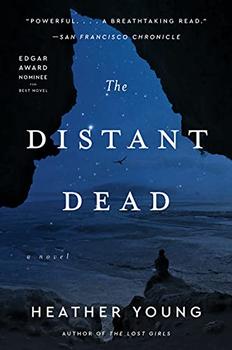Summary | Excerpt | Reviews | Beyond the Book | Read-Alikes | Genres & Themes | Author Bio

This article relates to The Distant Dead
 The evocative prehistorical scene with which Heather Young opens The Distant Dead might be fictional but, as the narrator suggests near the end of the novel, it parallels some real-life archaeological discoveries. One of these is Anzick Boy, or Anzick-1, a Paleoindian child of one or two years old, found buried in Montana in 1968. This specimen is the earliest known burial in North America. The child was buried with more than one hundred stone and bone tools.
The evocative prehistorical scene with which Heather Young opens The Distant Dead might be fictional but, as the narrator suggests near the end of the novel, it parallels some real-life archaeological discoveries. One of these is Anzick Boy, or Anzick-1, a Paleoindian child of one or two years old, found buried in Montana in 1968. This specimen is the earliest known burial in North America. The child was buried with more than one hundred stone and bone tools.
Interestingly, the Anzick specimen was named for the family whose land he was found on, and Sarah Anzick (who was two years old at the time of the discovery) grew up to become a genome researcher and one of the scientists who helped sequence Anzick-1's nuclear genome (the set of DNA found within a cell's nucleus). The genetic profile suggests that the child—a member of the ancient Clovis people—was ancestral to current South and Central American Natives and also shared genetic material with earlier Siberian cultures.
There has been a fair amount of speculation, disagreement and reassessment concerning the age of Anzick-1. Based on the grave goods, or artifacts, with which he was buried, researchers date his burial to about 13,000 years ago. However, early carbon dating attempts on the remains themselves seemed at odds with those of the grave goods—sometimes to the tune of a thousand years or more. In 2018, however, a new approach that involves carbon testing on a single amino acid extracted from the skeleton seemed to validate the original assessment, that this young child was laid to rest about 13,000 years ago with tools and other artifacts of the Clovis culture into which he was born.
Archaeologists who researched Anzick-1 worked with Native people in an attempt to treat this significant burial site with respect. After obtaining the samples needed to conduct their genomic research, the researchers re-buried the remains on the original piece of land where they were unearthed. In an interview, Sarah Anzick recalled the delicate balancing act required when doing the research: "One of the most important things we learned... is that the scientific results need to be beneficial to the tribe and they need to be shared... Scientists need to be willing to make sacrifices and compromises, like reburying the skeleton. That was a sacrifice for the scientific community because there was so much more we could have learned. But I was happy to do it." The handling of the Anzick-1 skeleton offers a useful model for how scientific research can progress while also respecting Native cultures.
The bluff near Wilsall, Montana where the Anzick child was discovered along with numerous artifacts. Source: Anthro Research (CC BY-SA 3.0)
Filed under Cultural Curiosities
![]() This "beyond the book article" relates to The Distant Dead. It originally ran in July 2020 and has been updated for the
August 2021 paperback edition.
Go to magazine.
This "beyond the book article" relates to The Distant Dead. It originally ran in July 2020 and has been updated for the
August 2021 paperback edition.
Go to magazine.
Your guide toexceptional books
BookBrowse seeks out and recommends the best in contemporary fiction and nonfiction—books that not only engage and entertain but also deepen our understanding of ourselves and the world around us.